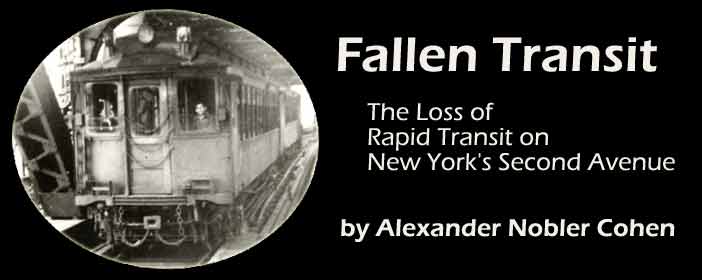

![]() levated railroads once wended all over Manhattan. In the early 1930's there were lines along Second, Third, Sixth, and Ninth Avenues, with branches reaching into the Bronx and Queens. These railways, known as "els," predated the subway by several decades. The first line opened in 1868 while New York's first subway would not open until 1904. Compared to subways, els had obvious disadvantages. Robert Reed, author of The New York Elevated, calls the structures an "uproar to the eye" and explains why the els were obnoxious to both eye and ear:
levated railroads once wended all over Manhattan. In the early 1930's there were lines along Second, Third, Sixth, and Ninth Avenues, with branches reaching into the Bronx and Queens. These railways, known as "els," predated the subway by several decades. The first line opened in 1868 while New York's first subway would not open until 1904. Compared to subways, els had obvious disadvantages. Robert Reed, author of The New York Elevated, calls the structures an "uproar to the eye" and explains why the els were obnoxious to both eye and ear:
Though there may have been some abstract beauty to the diminishing perspective of the structure with its lacy bower of iron supports receding far into the distance, the reality was no doubt far less romantic. The elevated was an unsightly blemish to many neighborhoods, blocking some magnificent, wide avenues with its great columns and creating interminable, dark tunnels where there had been sunlight.
It darkened the streets and lower stories of many stores and homes, particularly at the corners where stairs and stations were built, and the shade kept the streets damp and wet long after others were dry. ... Of all the uproar caused by the elevated roads the worst seems to have been the noise – the deafening, bewildering racket of countless trains thundering along the overhead iron bridge, every sound and vibration intensified and reflected downward by the huge sounding board of the structure and the car bottoms. Along the lines the furious din caused by the pounding of the car wheels on the track was almost continuous. The roar of metal striking against metal was like a hammer on an anvil, the crash echoing and reechoing through the hundreds of iron girders and braces and sweeping in undulating waves through the streets, ricocheting and reverberating through the brick and stone canyons of the city.
Considering the unpleasantness of the els, it is obvious why, by the 1930s, there was a movement afoot to replace them with subways. The city's new Independent (IND) subway system included lines that deliberately competed with privately-operated elevated routes, so that the els could be torn down. In fact, service ended on the Sixth Avenue el in 1938, as construction progressed on the new Sixth Avenue subway.In the early 1940's, under the Mayoralty of Fiorello La Guardia, the Second and Ninth Avenue els also were abandoned and demolished. An IND subway along Eighth Avenue replaced the Ninth Avenue el, but there was no replacement subway for the Second Avenue el. There were plans drawn out for a Second Avenue subway, but the plans were never brought to fruition. When the Second Avenue el came down, New York lost a rapid transit line, and the city's era of incredible transit expansion came to an end.
Updated
©2001 Alexander Nobler Cohen. ©2001 The Composing Stack Inc. All rights reserved